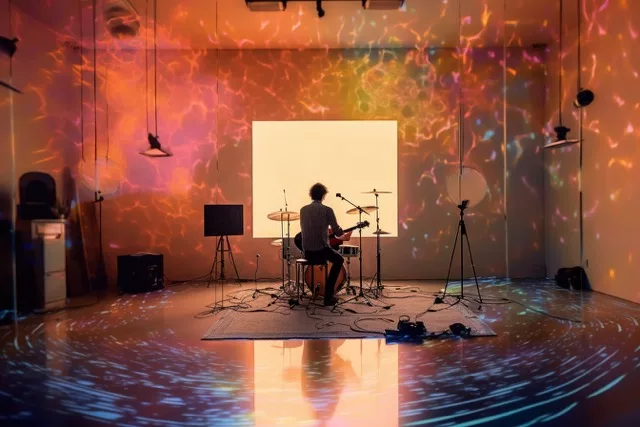Recording good audio for your music videos is not a dark art. It is something that you can get right, with enough practise.

As a musician, your talent shines not only through the melody but also the quality of your sound. Recording good audio means less noise, and less distortion. This will enable your audience to enjoy your music and help other musicians to take you seriously.
In this post, I’ll share some practical tips on recording good audio that will help you achieve professional level without breaking the bank. These tips range from using an external audio interface and selecting the right room to monitoring audio levels and using a dedicated microphone.
So, let’s dive in and make your music videos sound as impressive as they look.
Before hitting the record button, ensure your audio levels are just right. They shouldn’t be too loud, causing distortion, or too soft, making your sound hard to hear.
Most recording apps, including Djaminn, provide a visual audio level meter you can use to check your audio levels. Need help with this? Check our support centre at support.djaminn.com.
More insights on perfecting your music videos are provided in our series – guides for making great songs on social platforms like Djaminn, TikTok and Instagram.


Choosing the right room for recording audio for music videos is paramount. Opt for a quiet room with good acoustics.
Ideal rooms have soft surfaces, like carpets and curtains. These absorb sound and prevent it from bouncing around, thereby causing echo or reverb. Hard surfaces, like tiles or wood, can cause sound reflections, leading to a hollow or distant sound in your recording.
We cover this and more in our support centre at support.djaminn.com.

It is important to place the microphone close to you when playing. This will help to capture the sound more accurately and with less background noise. However, it is important not to place the microphone too close to your instrument, as this can cause distortion.
Distortion occurs when the microphone is overloaded with sound. This can cause the sound to become harsh and unpleasant to listen to. To avoid distortion, it is important to experiment with different microphone placements until you find a distance that works well for your recording.
As a general rule of thumb, you should place the microphone about 6-12 inches away from the source of the sound. However, this distance may vary depending on the type of microphone and the sound you are trying to capture. For example, you may need to place a microphone closer to you if you are singing.
If you are unsure how close to place the microphone, it is always better to err on the side of caution and place it further away. This will help to avoid distortion and ensure that your recording sounds its best.
Recording good audio on your songs will be significantly easier when using a standalone microphone instead of the one built into your phone or headset. This is because standalone microphones are designed to capture sound more accurately and with less background noise. They have better components and are designed to be used in a professional setting.
When recording vocals or acoustic instruments, it is important to use a microphone that is designed for that purpose. For vocals, a condenser microphone is a good choice. Condenser microphones are sensitive and can capture a wide range of frequencies, which is ideal for capturing the human voice. For acoustic instruments, a dynamic microphone is a good choice. Dynamic microphones are less sensitive than condenser microphones, which makes them less susceptible to feedback and noise.. Check out how other musicians are sounding, by downloading the Djaminn app here.
Djaminn supports the use of IK-media gear, allowing you to use professional connections like Jack plugs and XLR plugs. This gear can provide you with more control and better sound quality during your recording sessions. To get started, download the Djaminn app here.
By implementing these tips, you will be well on your way to recording audio for music videos that not only looks good but sounds fantastic. However, creating engaging music videos also involves composing an engaging environment. Be sure to check out the all the guides in this series where I’ll delve into how to improve your music video game.
And don’t miss the other helpful posts in this series: “5 Tips for Great Lighting in Music Videos for Social Media” and “5 Tips for Great Performance in Music Videos for Social Media”.
By integrating these tips with your innate creativity, you’ll be creating mesmerising music videos with exceptional audio quality in no time.